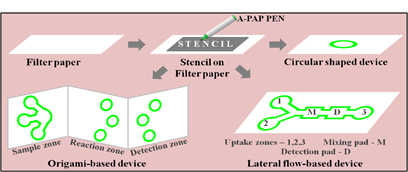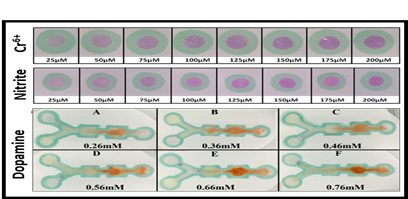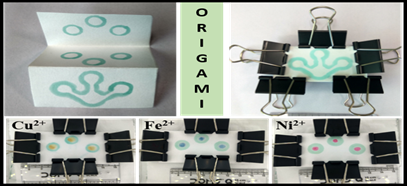Ministry of Science & Technology
New paper-based device can simplify sensing of the contaminants
प्रविष्टि तिथि:
18 SEP 2024 2:22PM by PIB Delhi
Scientists have developed a novel and cost-effective technique for fabricating paper-based devices using an Advanced PAP (A-PAP) pen, which offers a practical alternative to conventional sensing methods that necessitate specialized equipment and expertise making it suitable for resource-limited settings.
In recent years, paper-based devices have gained more consideration as promising platforms for point-of-care diagnostics owing to the factors such as simplicity, cost-effectiveness, disposability, and mobility. There are various methods for fabricating paper-based devices such as inkjet printing, wax printing, laser treatment and correction pens. However, these fabrication processes typically entail the use of complex instruments, machinery or may require heating/drying steps which limits their accessibility in resource-limited settings.
Research group led by Dr. Bhanu Prakash at Institute of Nano Science and Technology (INST), Mohali, an institute of Department of Science and Technology, explored a new fabrication technique using a PAP pen that does not require any machinery or heating/drying steps and adopts a DIY approach.
Using the A-PAP pen, they have fabricated two-dimensional (2D) paper-based devices for chemical detection of heavy metal and nitrite. They have also demonstrated the versatility of fabrication technique for biological sensing using 2D lateral flow paper-based devices for the detection of dopamine. Furthermore, the technique is also validated for fabricating complex three-dimensional (3D) paper-based devices using a paper origami technique for heavy metals sensing. The ready-to-use devices can be fabricated in seconds, making them convenient for on-the-spot testing. Overall, this technique provides a valuable tool for creating affordable, efficient, and accessible chemical and biological testing solutions.
The device does not require any sophisticated instrumentation or a heating step, making it a promising technology for resource-limited settings.
The paper-based devices fabricated are distinguished by rapid, simple, and cost-effective fabrication and the DIY approach offers a low-cost solution particularly beneficial for developing countries and remote areas.
The fabrication using A-PAP pen is advantageous when compared to other techniques because of the omission of the heating/drying step thereby enabling the rapid fabrication in around 10 seconds with superior contact angle suitable for testing and sensing applications. Its versatility extends to fabricating simple and complex devices like lateral-flow-based and 3D origami devices. The fabricated paper-based devices represent a cost-effective and user-friendly technique for identifying and quantifying contaminants in diverse matrices such as water and food.
The method offers a promising solution for affordable and accessible sensing applications, particularly in resource-limited settings where sophisticated laboratory equipment is scarce.
Publication Link: https://doi.org/10.1016/j.talo.2024.100325



***
PSM/AG
(रिलीज़ आईडी: 2055953)
आगंतुक पटल : 1305